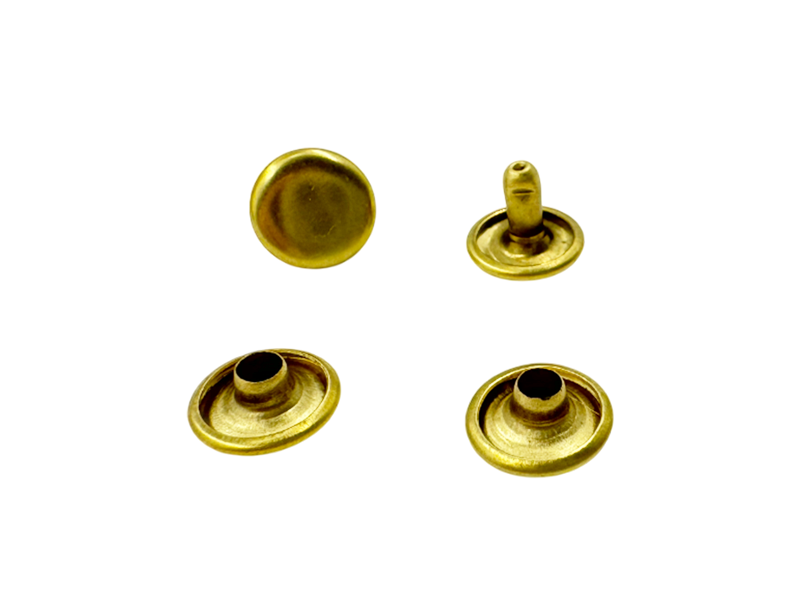Ever been frustrated when a rivet fails, ruining your leather project? Or maybe you struggle to pick the right rivet, leading to an unprofessional finish. Choosing the correct rivet is essential for strong, attractive, and lasting leatherwork. This guide will cover solid, tubular, split, and decorative leather rivets, empowering you to make the best choices for every project.

Understanding Rivet Anatomy
Before diving into rivet types, it is important to grasp the parts that make them whole. Knowing these basic components will make rivet selection and usage much simpler.
Rivet Head Styles
Rivet heads come in different shapes, each offering unique style and function. Dome heads offer a classic, rounded look and are great for general use. Countersunk heads sit flush with the leather surface, giving a sleek, low-profile appearance. Flat heads provide a simple, industrial feel. It's important to consider if the head style fits with the desired aesthetic of your design.
Rivet Post Length and Diameter
The post, also called the shank, is the part of the rivet that goes through the materials being joined. To measure the post length, measure the thickness of the leather being fastened plus a little extra for setting. The diameter of the post affects the strength of the bond. Thicker leather often requires a larger diameter. Using the proper size leads to solid connections and avoids loose or wobbly rivets.
Rivet Materials
Rivets come in many materials, each with benefits and drawbacks. Brass rivets offer a classic gold look and resist corrosion. Copper rivets are durable and add a rustic touch. Steel rivets bring maximum strength for heavy-duty projects. Aluminum rivets are lightweight and resist rust, which is useful for items exposed to weather. Consider the look you want and conditions the item will face when choosing your material.
Solid Rivets: Strength and Durability
Solid rivets are known for their strength and permanent hold. These rivets are a single piece of metal, making them very strong. They are used for projects needing maximum strength, like saddles, holsters, and heavy bags.
Advantages of Solid Rivets
Solid rivets have unmatched strength and can hold up to a lot of stress. These rivets form a permanent bond, ensuring the fastened pieces will not separate. Solid rivets hold well for items used frequently or in tough conditions.
Setting Solid Rivets
Setting solid rivets calls for specific tools and techniques. You will need a rivet setter, also known as an anvil, and a hammer. Place the rivet through the materials, then put the rivet head on the anvil. Use the hammer to strike the setter, deforming the rivet tail and making a secure hold. Proper setting ensures the rivet's strength and long life.
Tubular Rivets: Versatile Fasteners
Tubular rivets, sometimes called semi-tubular rivets, have a hollow end. The design lets the rivet compress when set. This makes them useful in many leather projects.
Applications of Tubular Rivets
Tubular rivets are useful for many projects such as bags, belts, and garments. They work great for places that need a blend of strength and a cleaner look. Using them on bags and belts can create strong, yet subtle, connections. Garments use them to add both flair and function.
Setting Tubular Rivets
Setting tubular rivets calls for special tools. The tools compress the hollow part of the rivet, creating a tight bond. You can use a manual hand press or a rivet-setting machine. Either way, ensure the rivet is correctly set. That setting will result in a clean, professional finish.
Split Rivets: Easy Installation
Split rivets are unique because of their easy installation. These rivets have a split post that spreads apart when pressed through leather. This feature makes them ideal for quick fixes and projects where strength is not a top concern.
Advantages of Split Rivets
Split rivets are easy to install, needing only basic tools or even just your hands. The split design lets the rivet grip the leather, holding pieces together without needing precise setting. This makes them great for quick repairs or temporary fixes.
Types of Decorative Rivets
Decorative rivets include star rivets, pronged rivets, and crystal rivets. Star rivets add a bold, edgy look. Pronged rivets offer a secure hold and a unique visual texture. Crystal rivets bring sparkle and elegance to leather goods. Pick the rivet that matches the project's style.
Installing Decorative Rivets
Installing decorative rivets needs care to ensure they stay secure and look good. Some rivets, like pronged ones, need you to pierce the leather before installing. Others might need a special setting tool to keep the decorative element intact. Secure installation ensures the rivet stays put and enhances the item's look.
Rivet Size Chart
Leather Thickness(mm) | Recommended Rivet Post Length(mm) |
| 2-3 | 5-6 |
| 4-5 | 7-8 |
| 6-7 | 9-10 |
| 8-9 | 11-12 |
This table is a general guide. Always test the fit before finalizing your rivet choice.
Submit for an Online Quote:
Send us (sale803@jiliang988.com) the completed form along with your drawing, and we’ll provide you with a fast and competitive quote.
If you have any questions or need assistance, feel free to contact us. We’re here to help!

 Language
Language








